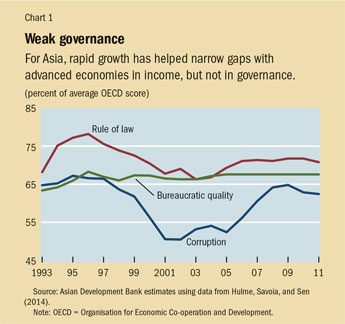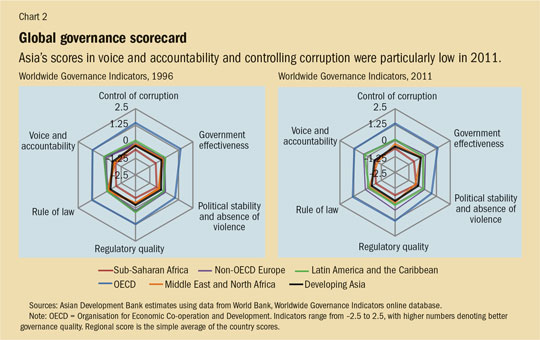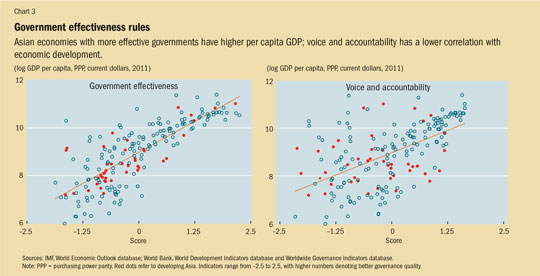Governance Unbundled
Finance & Development, June 2014, Vol. 51, No. 2
By focusing on the biggest hurdles to growth and development, countries in Asia are more likely to see their governance reform efforts succeed

GOOD governance—which requires transparency, accountability, rule of law, and effective and legitimate institutions—is believed to be an important piece of economic development, while poor governance can hobble growth in an otherwise vibrant system.
But the rapid economic growth that helped developing Asia narrow the income gap with advanced economies and lift millions out of poverty occurred despite a governance scorecard that—according to standard criteria—has been poor and variable.
What explains this apparent contradiction? To figure out the role of governance in Asia’s prosperity, we draw on a rich body of research and find that there is more to the question than good versus bad governance. Different elements may come into play at different stages of a country’s development. And not all aspects of governance carry equal weight at a particular point in time. Governance reform priorities need to take into account cultural and institutional realities, by focusing on areas that address the biggest hurdles to a country’s growth and development.
The Asian tigers
Asia’s economic advance is well known. Following Japan’s rapid recovery from World War II and expanding economic influence regionally, the economies of Hong Kong SAR, Korea, Singapore, and Taiwan Province of China became what is termed “newly industrialized”—they rose from poverty to high-income status within a generation. Then market reforms in China opened the way for its sustained rapid economic growth. In the past decade, India, Indonesia, Malaysia, the Philippines, Thailand, and Vietnam emerged as Asia’s newest tigers.
These changes have transformed the global economic landscape. Over the past three decades, developing Asia’s per capita GDP in purchasing-power-parity (PPP) terms increased by a factor of 14—from $497 in 1980 to $6,844 in 2012, growing on average by 8.5 percent a year. Except for a dip during the 1997–98 Asian financial crisis, economic growth has largely been consistent, even after the recent global financial crisis. Developing Asia now accounts for about one-third of global GDP in PPP terms.
With higher growth, the region has made significant progress in reducing poverty (ADB, 2013). Between 1990 and 2010, some 700 million people were lifted out of extreme poverty. Among nonincome indicators of poverty, primary education for both girls (89 percent) and boys (91 percent) is now nearly universal; child mortality declined by half between 1990 and 2011; and more than 85 percent of households have access to safe drinking water today, up from about 75 percent in 1990.
But these remarkable achievements are not matched by similar progress on governance.
Measuring governance
The concept of governance is broad—but nearly always includes voice and accountability, political stability and absence of violence, government effectiveness, regulatory quality, rule of law, and control of corruption.
Various sets of indicators use widely different approaches to quantify aspects of governance, but all tell a consistent story of persistent weak governance in Asia.

One set of indicators—produced by the International Country Risk Guide (ICRG) since 1980—suggests poor overall quality of governance in Asia relative to Organisation for Economic Co-operation and Development (OECD) countries with limited convergence (see Chart 1). Since 1993, indicators covering the rule of law and bureaucratic quality gained only slightly compared with average OECD scores. Following the 1997 Asian financial crisis, as the affected countries focused on measures to deal with the crisis, institutions and systems for containing corruption deteriorated considerably, and it took time for them to become effective again.
The Worldwide Governance Indicators (WGIs)—a World Bank data set—show results similar to ICRG indicators (Chart 2). OECD countries had the strongest scores among global regions on all indicators in 1996 and 2011. At the opposite end of the scale, the scores for sub-Saharan Africa were the lowest in 2011, with the exception of political stability and absence of violence and voice and accountability. For all the indicators, developing Asia scored only moderately better than sub-Saharan Africa and close to the Middle East and North Africa—the two regions where the pace of growth and poverty reduction was much slower. Developing Asia’s scores were generally lower than those of Latin America and the Caribbean, non-OECD Europe, and OECD countries. Among the six dimensions of WGIs, the region’s scores in voice and accountability and control of corruption were particularly low in 2011. This pattern was persistent and did not change much between 1996 and 2011.

Developing Asia’s overall ranking among global regions improves somewhat after controlling for income differences. This is shown by the average deviation of Asian countries’ actual scores from the global benchmark, which indicates the global average scores at each level of per capita income for the corresponding WGI (ADB, 2013). Developing Asia scored above the global benchmark for political stability and absence of violence. But it fell short with respect to the other five indicators. In particular, after controlling for income differences, developing Asia ranks the lowest—excluding the Middle East and North Africa—on voice and accountability, controlling corruption, and regulatory quality. Not surprisingly, these three elements of governance also show the widest gap between developing Asia’s average and that of the advanced OECD economies.
So developing Asia presents a paradox. Recent decades show consistently high economic growth despite relatively low ratings on governance. The region’s relative economic success appears to contradict the intuitive principle that good governance accompanies development. According to this view, good governance enables more efficient division of labor, higher productivity of investment, and efficient implementation of social and economic policies, all important drivers of sustained economic growth.
Is Asia different?
Empirical evidence shows that, on the whole, better governance is correlated with higher growth and better development outcomes. To resolve Asia’s conundrum, we consider four different ways of looking at that relationship.

First, by and large, there is a positive association between governance and economic development, and Asia is no exception. To illustrate the point, Chart 3 plots worldwide data for two WGIs—government effectiveness and voice and accountability—vis-à-vis a country’s per capita GDP. In both cases, the governance score is positively correlated with per capita GDP. The red dots in Chart 3 refer to developing Asian economies and show a similar positive association. Analysis of other governance indicators—regulatory quality, control of corruption, political stability, and rule of law and their correlation with per capita GDP, not shown here—also confirms this positive relationship.
Second, the relationship between governance and economic development varies across the various dimensions of governance. Chart 3 shows that government effectiveness is more closely correlated with per capita GDP than voice and accountability. In fact, government effectiveness has the highest correlation with per capita GDP among the six WGIs, and voice and accountability has the lowest. An Asian Development Bank study (ADB, 2013) uses a global data set to empirically estimate the relationship between GDP growth and governance quality. The results show that Asian countries that scored high (against a global benchmark, as explained earlier) on government effectiveness, regulatory quality, and control of corruption in 1998 grew faster—about 1.5 percentage points annually—during 1998–2011 than Asian countries that scored low. However, growth does not differ significantly between countries with high and low scores on political stability and rule of law, and in the case of voice, Asian countries that scored higher actually grew slower.
The same study reports results from a cross-country analysis between GDP growth and governance quality. The results show that all governance indicators have a positive and significant relationship with growth performance in the global sample of countries, and this relationship holds for Asian countries as well. However, government effectiveness and regulatory quality correlate much more strongly with growth in Asia than in the global sample. This suggests that Asian economies would benefit more by improving these two aspects of governance.
Third, the relationship between governance and economic development depends on a country’s stage of development as well. An examination of the relationship for all six WGIs shows that, by and large, correlation between governance and development is weaker among lower-income than among higher-income economies. This is especially true for voice and accountability. For example, data points in Chart 3 are widely scattered along the benchmarks among low- and middle-income countries but tighten among higher-income countries. This is also true for Asian countries. Perhaps countries face different binding constraints at different stages of development, and governance reform will more likely help support growth and development when it alleviates those constraints (Rodrik, 2008). Thus, in low- and middle-income countries, in addition to improving government effectiveness and regulatory quality, better implementation of rule of law and control of corruption take precedence. The associated governance reforms may push growth and development much more than other dimensions of governance. Although improvements such as voice and accountability have intrinsic value, they appear to have less of a role to play in supporting development outcomes when a country is at a low-income stage.
Fourth, the relationship between governance and economic development varies with individual indicators of development too. The ADB (2013) examines whether higher rankings on governance quality correlate with better development outcomes, and if the relationship holds equally well for developing Asia. Three mechanisms that transmit the benefits of good governance to development outcomes are considered: higher per capita income, especially for the poor; enhanced tax collection to enable more public spending on social development; and more effective social development spending and delivery of public services. The analysis yields two major results.
One, at the global level, better governance on most WGI indicators generally correlates with better development outcomes: lower rates of extreme poverty, a higher human development index, less gender inequality, lower maternal and under-5 mortality rates, better access to sanitation, higher levels of education, better infrastructure, and a more reliable electricity supply.
Two, the link between governance and infrastructure quality and reliability is stronger in Asia than in other parts of the world. In other words, weak governance holds back infrastructure development much more in Asia than elsewhere—a critical constraint to future development. Asia’s relationship between governance, on the one hand, and some measures of human development, such as extreme poverty, under-5 mortality, and years of schooling on the other, resembles that in the rest of the world. However, the link between governance (especially voice and accountability and government effectiveness) and other measures of human development—such as gender inequality, maternal mortality, and access to improved sanitation—is weaker in Asia. This can perhaps be explained by deep-rooted cultural values and social norms. Thus, another explanation underlying the conundrum of remarkable achievements in development at the aggregate level that are not matched by improvements in governance may be found in the individual development indicators.
Policymakers must consider three issues
First, governance matters for growth and development. Worldwide data show that faster growth and better development performance are associated with better governance, in particular with government effectiveness, regulatory quality, rule of law, and controlling corruption. The link between growth and two indicators—government effectiveness and regulatory quality—is stronger in Asia than elsewhere. However, it is more difficult to establish a causal relationship between the two. A plausible interpretation is two-way causality between better governance quality and higher development performance: one reinforces the other. Thus, it pays to improve both.
Second, the relevance of different elements of governance varies with a country’s stage of development. Low-income countries should strive for more effective government, better regulatory quality and rule of law, and tighter control on corruption (for example, conflict prevention, support for human rights, and provision of essential public services). And graduating to higher income entails improving governance quality with respect to citizen participation and government accountability. Middle- and higher-income countries are likely to reap considerable rewards from their citizens’ greater voice, political stability, and world-class institutions (for example, effective legal systems, high-quality health and education services, and well-developed financial systems).
Third, the payoffs to governance reforms vary with individual indicators of development. Corruption prevents public service programs from reaching the poor, while weak regulatory regimes and ineffective government throw a monkey wrench into businesses’ growth and infrastructure investment much more in Asia than elsewhere. Moreover, social norms influence gender outcomes and sanitation practices in Asia. In countries that face widespread market failure, governments should focus on removing or reforming the most binding development constraints. Because countries with different initial conditions have different binding constraints, they will require tailored governance reform policies.
As development goals in themselves, all dimensions of governance should be pursued. Policymakers should focus not only on what is relatively easy to implement quickly but on steps with the most visible impact on development. High-quality institutions will help fast-growing economies avoid the middle-income trap and enable slow-growing economies to establish the conditions necessary for sustained economic growth. ■
Shikha Jha is Principal Economist and Juzhong Zhuang is Deputy Chief Economist of the Asian Development Bank’s Economics and Research Department. This article is largely based on Part 2 of ADB (2013).
References
Asian Development Bank (ADB), 2013, Asian Development Outlook 2013 Update: Governance and Public Service Delivery (Manila).
Hulme, David, Antonio Savoia, and Kunal Sen, 2014, Governance as a Global Development Goal? Setting, Measuring and Monitoring the Post–2015 Development Agenda, Effective States and Inclusive Development Research Centre Working Paper No. 32 (Manchester, United Kingdom: University of Manchester).
Rodrik, Dani, 2008, “Thinking about Governance,” in Governance, Growth, and Development Decision-Making (Washington: World Bank).





